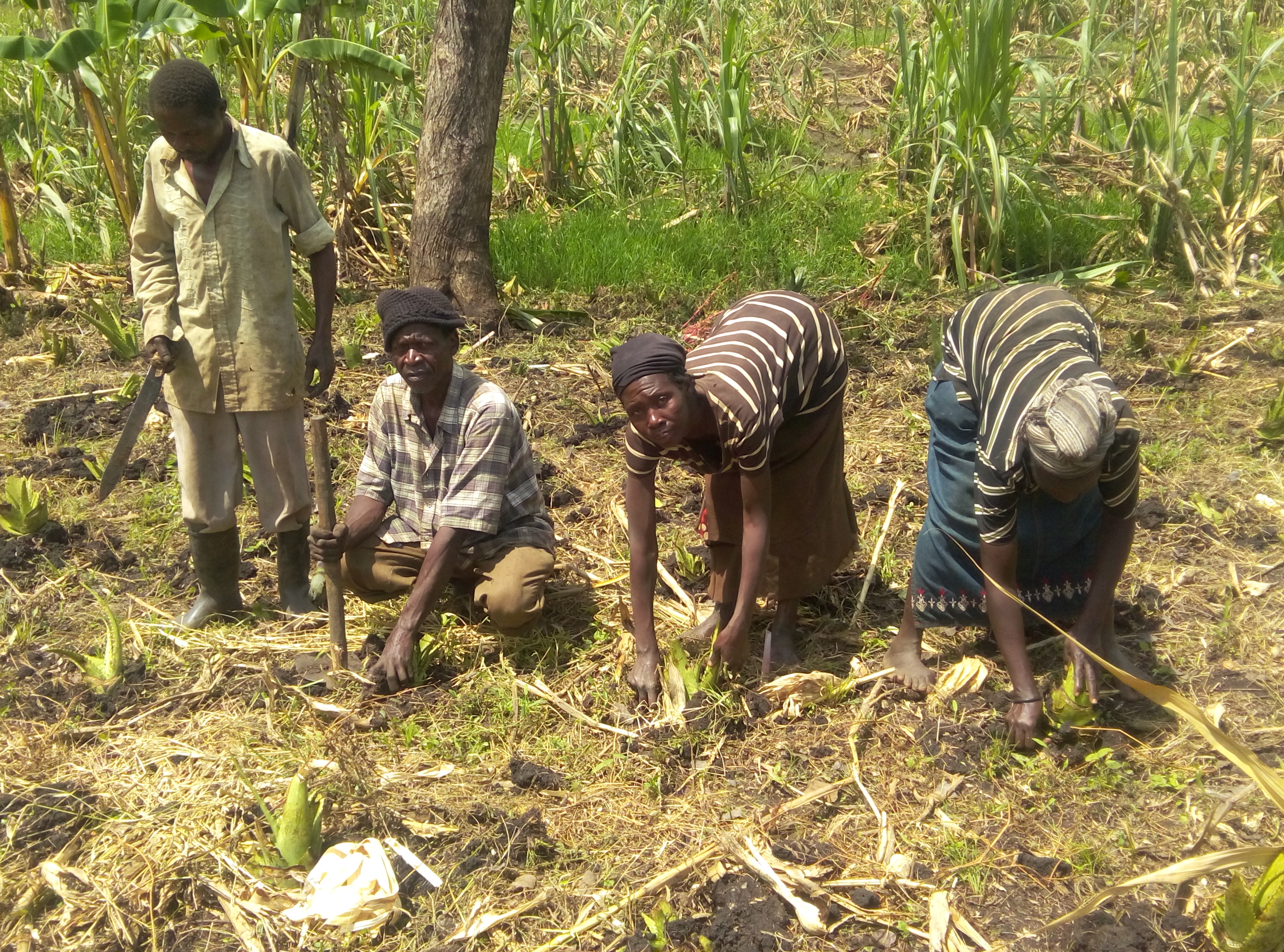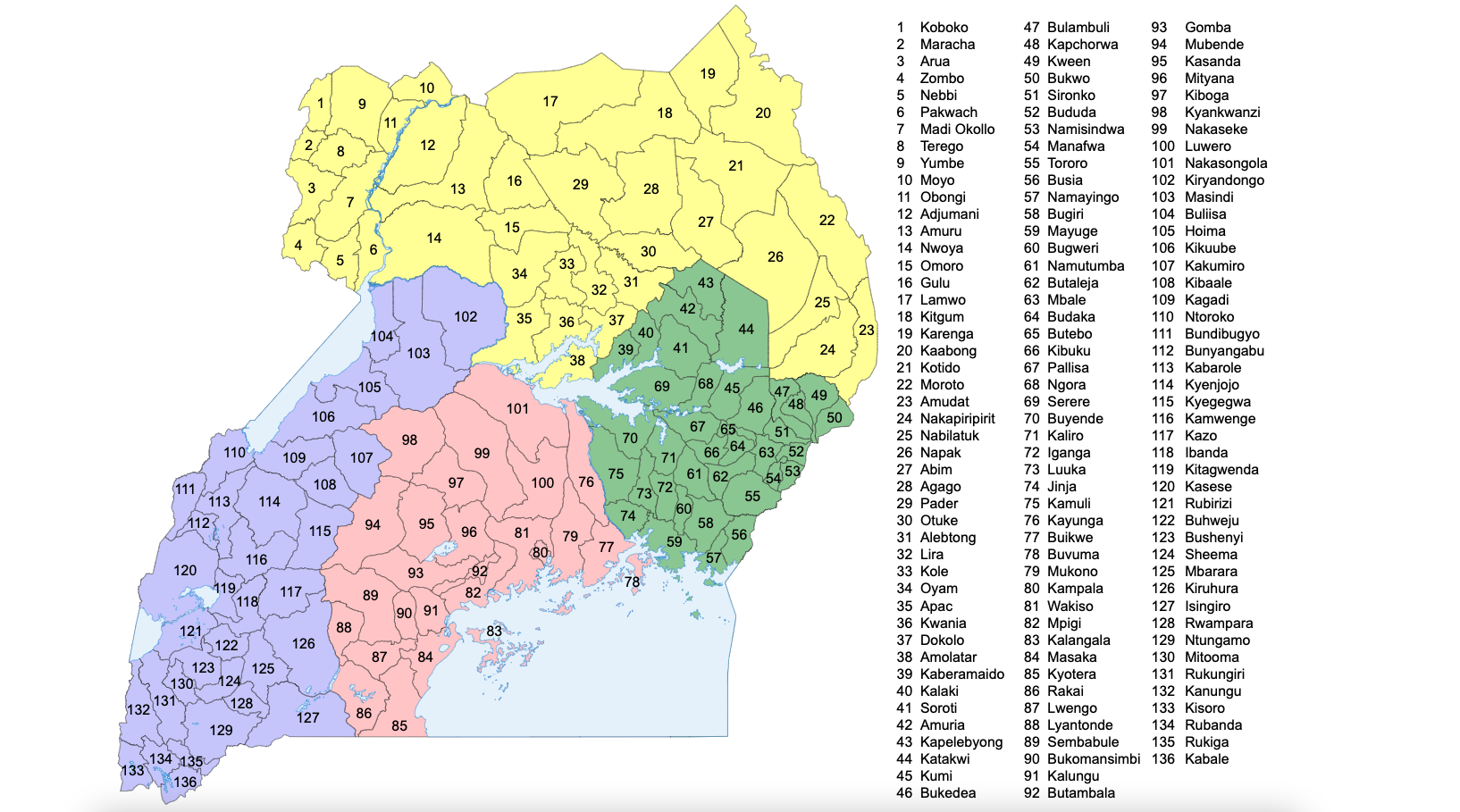|
Sironko
Sironko is the largest metropolitan area in Sironko District of the Eastern Region of Uganda and the site of the district headquarters. Geography Sironko lies northeast of the city of Mbale on the highway between Mbale and Moroto. It is located northeast of Kampala, Uganda's capital and largest city. The coordinates of the town are 01°13'50.0"N, 34°14'53.0"E (Latitude:1.230556; Longitude:34.248056). Sironko sits at an average elevation of above mean sea level. Overview Sironko is the location of the headquarters of Sironko District, one of the six Ugandan districts in the Bugisu sub-region. The town is administered by Sironko Town Council, headed by a mayor. It is one of the only two town councils in the district, as of June 2020. The other town in the district is Budadiri Town. Sironko town lies at the foothills of Mount Elgon. The area is prone to landslides and flooding. On more than one occasion, landslides have killed people and caused damage and loss of propert ... [...More Info...] [...Related Items...] OR: [Wikipedia] [Google] [Baidu] |
Sironko District
Sironko District is a district in the Eastern Region of Uganda. The district was created in 2000 and had previously been part of Mbale District. Sironko is the main commercial town in the district. Location Sironko District is bordered by Bulambuli District to the north, Kapchorwa and Kween Districts to the north-east, Kenya to the east, Bududa District to the south-east, Mbale District to south-west, and Bukedea District to the west. Sironko lies north-east of Mbale, the largest city in the Bugisu sub-region. Population In 1991, the national population census estimated the district population at 147,700. The 2002 census estimated the population at 185,800, with an annual growth rate of 2.6 percent. The population was estimated to be 239,600 in 2012. Geography The district has a total area of . Major towns Sironko is the largest town and the administrative headquarters of the district. Mafuni, Nakaloke, Mutufu, and Budadiri are the main trading centers within the district. ... [...More Info...] [...Related Items...] OR: [Wikipedia] [Google] [Baidu] |
Budadiri
Budadiri is a town in the Eastern Region of Uganda. It is one of the urban centers in Sironko District. Location Budadiri is located approximately , by road, southeast of Sironko, where the district headquarters are located. This is approximately , by road, north-east of Mbale, the largest city in the Bugisu sub-region. The geographical coordinates of the town are:01°10'17.0"N, 34°20'06.0"E (Latitude:1.171389; Longitude:34.335000). Budadiri is situated at an average elevation of above sea level. Overview Budadiri is located within Mount Elgon National Park, at the foothills of Mount Elgon. The town is a popular staging area and base camp for climbers who would like to scale the mountain. Budadiri was awarded Municipality status on 1 July 2009. The town is served by ''Budadiri Health Centre IV'', a medical facility operated by the Ugandan Ministry of Health in conjunction with the Sironko District Local Government. In 2015, Sarah Achieng Opendi, the then State Minister in ... [...More Info...] [...Related Items...] OR: [Wikipedia] [Google] [Baidu] |
Eastern Region, Uganda
The Eastern region is one of four Regions of Uganda, regions in Uganda. As of Uganda's 2014 census, the region's population was . Districts , the Eastern Region contained 32 Districts of Uganda, districts: References External links Google Map of the Eastern Region of Uganda {{Districts of Uganda Eastern Region, Uganda, Regions of Uganda ... [...More Info...] [...Related Items...] OR: [Wikipedia] [Google] [Baidu] |
Districts Of Uganda
As of 1 July 2020, Uganda is divided into 135 districts plus the capital city of Kampala, which are grouped into four Regions of Uganda, geographic regions. Since 2005, the Ugandan government has been in the process of dividing districts into smaller units. This decentralization is intended to prevent resources from being distributed primarily to chief towns and leaving the remainder of each district neglected. Each district is further divided into Counties of Uganda, counties and municipalities, and each county is further divided into Sub-counties of Uganda, sub-counties. The head elected official in a district is the chairperson of the Local Council (Uganda), Local Council five (usually written with a Roman numeral V). Districts created since 2015 In September 2015, the Parliament of Uganda created 23 new districts, to be phased in over the next four years. ;Notes: See also * List of constituencies in Uganda * Regions of Uganda * Uganda Local Governments ... [...More Info...] [...Related Items...] OR: [Wikipedia] [Google] [Baidu] |
Bugisu Sub-region
Bugisu sub-region is a region in Eastern Uganda that consists of the following districts: * Bududa District * Bulambuli District * Manafwa District * Mbale District * Namisindwa District * Sironko District The sub-region is home mainly to the Gisu people, also called Bagisu, (singular is ''Mugisu''). The Bagisu speak Lugisu, a dialect of Lumasaba, a Bantu language. Lugisu is very similar to the Bukusu language spoken of the Bukusu people of Kenya. According to the 2002 national census, the Bugisu sub-region was home to an estimated 1 million people at that time. Estimated Population of Bugisu Sub-region In 2002 See also * Regions of Uganda * Districts of Uganda As of 1 July 2020, Uganda is divided into 135 districts plus the capital city of Kampala, which are grouped into four Regions of Uganda, geographic regions. Since 2005, the Ugandan government has been in the process of dividing districts into sm ... References Sub-regions of Uganda Eastern Region, Uga ... [...More Info...] [...Related Items...] OR: [Wikipedia] [Google] [Baidu] |
List Of Cities And Towns In Uganda
This is a list of cities and towns in Uganda: The population data are for 2014, except where otherwise indicated. The references from which the estimated populations are sourced are listed in each article for the cities and towns where the population estimates are given. Twenty largest cities by population The following population numbers are from the August 2014 national census, as documented in the final report of November 2016, by the Uganda Bureau of Statistics (UBOS). Cities In May 2019, the Cabinet of Uganda approved the creation of 15 cities, in a phased manner, over the course of the next one to three years, as illustrated in the table below. The 7 of the 15 cities started operations on 1 July 2020 as approved by the Parliament of Uganda. Municipalities References External links Uganda: Regions, Major Cities & Towns - Population as per 2014 Census {{Africa topic, List of cities in Populated places in Uganda, Lists of cities by countr ... [...More Info...] [...Related Items...] OR: [Wikipedia] [Google] [Baidu] |
Gisu
The Gisu people, or ''Bamasaba'' people of Elgon, are a Bantu tribe and Bantu-speaking ethnic group of the Masaba people in eastern Uganda, closely related to the Bukusu people of Kenya. Bamasaba live mainly in the Mbale District of Uganda on the slopes of Mount Elgon. The Bagisu are estimated to be about 1,646,904 people making up 4.9% of the total population according to the 2014 National Census of Uganda. Religion The majority of the Bagisu people are Christians mainly Anglican (Church of Uganda) estimated at 45.7% while a significant percentage are Roman Catholic estimated at 29.1%. Around 14% of the Bagisu people follow Islam according to the 2002 Census of Uganda and 5.3% are Pentecostal. Ancestor The Masaba, Bukusu and Luhya people believed that their ancestors were Mundu and Sera. The people of Ethiopia and the Ethiopian Highlands have no name for Kundu, except that it is a mountain peak in Oromiya. The Bamasaba ancestor, Masaba migrated from the Ethiopian Mountains tr ... [...More Info...] [...Related Items...] OR: [Wikipedia] [Google] [Baidu] |
Mbale
Mbale is a city in the Eastern Region of Uganda. It is the main municipal, administrative, and commercial center of Mbale District and the surrounding sub-region. Location Mbale is approximately northeast of Kampala, Uganda's capital city, on an all-weather tarmac highway. The city lies at an average elevation of above sea level. The coordinates of the city are 1°04'50.0"N, 34°10'30.0"E (Latitude:1.080556; Longitude:34.175000). The city is on the railway from Tororo to Pakwach. Mount Elgon, one of the highest peaks in East Africa, is approximately , north-east of Mbale, by road. Population According to the 2002 census, the population of Mbale was about 71,130. In 2010, the Uganda Bureau of Statistics (UBOS) estimated the population at 81,900. In 2011, UBOS estimated the mid-year population at 91,800. The 2014 population census put the population at 96,189. Twinning Mbale was formally linked with the town of Pontypridd, Wales through local and regional twinning ceremonie ... [...More Info...] [...Related Items...] OR: [Wikipedia] [Google] [Baidu] |
Regions Of Uganda
The regions of Uganda are known as Central Region, Uganda, Central, Western Region, Uganda, Western, Eastern Region, Uganda, Eastern, and Northern Region, Uganda, Northern. These four regions are in turn divided into Districts of Uganda, districts. There were 56 districts in 2002, which expanded into 111 districts plus one city (Kampala) by 2010. The national government interacts directly with the districts, so regions do not have any definite role in administration. Under British rule before 1962, the regions were functional administrative units and were called provinces, headed by a Provincial Commissioner. The central region is the kingdom of Buganda, which then had a semi-autonomous government headed by the Kabaka (king). The equivalent of the Provincial Commissioner for Buganda was called the Resident.Uganda Protectorate annual report, Government Printer, Entebbe, 1959 At Uganda's 2002 census, the Central region (It is coterminous with the Kingdom of Buganda, one of the an ... [...More Info...] [...Related Items...] OR: [Wikipedia] [Google] [Baidu] |
Uganda Bureau Of Statistics
The Uganda Bureau of Statistics ("UBOS") is an agency of the Ugandan government. Formed by the Uganda Bureau of Statistics Act, 1998, the agency is mandated to "coordinate, monitor and supervise Uganda's National Statistical System". Location The headquarters of UBOS are located in Statistics House, at Plot 9 Colville Street on Nakasero Hill, in Kampala, Uganda's capital and largest city. This is at the corner of Colville Street and Nile Avenue. The coordinates of Statistics House are 0°18'58.0"N, 32°35'05.0"E (Latitude:0.316111; Longitude:32.584722). Overview The agency is supervised by the Uganda Ministry of Finance, Planning and Economic Development. UBOS is governed by a seven-person board of directors A board of directors is a governing body that supervises the activities of a business, a nonprofit organization, or a government agency. The powers, duties, and responsibilities of a board of directors are determined by government regulatio .... Its scope of wo ... [...More Info...] [...Related Items...] OR: [Wikipedia] [Google] [Baidu] |
Prime Minister Of Uganda
The prime minister of Uganda chairs the Cabinet of Uganda, although the President of Uganda, president is the effective head of government. The prime minister is appointed by the president with the approval of Parliament of Uganda, Parliament. Robinah Nabbanja has been the prime minister since 21 June 2021. History The post of prime minister was created for the first time in 1962. In 1966, Prime Minister Milton Obote suspended the Constitution of Uganda, Constitution, abolished the post of prime minister, and declared himself president. In 1980, the post of prime minister was re-established. Office The headquarters of the office of the prime minister of Uganda are located in the Twin Towers on Sir Apollo Kaggwa Road, in the Kampala Central Division, Central Division of Kampala, Uganda's capital and largest city. The coordinates of the headquarters are 0°18'58.0"N, 32°35'13.0"E (Latitude:0.316111; Longitude:32.586944). List of officeholders ;Political parties ;Other fa ... [...More Info...] [...Related Items...] OR: [Wikipedia] [Google] [Baidu] |
Mount Elgon
Mount Elgon is an extinct shield volcano on the border of Uganda and Kenya, north of Kisumu and west of Kitale. The mountain's highest point, named "Wagagai", is located entirely within Uganda."Mount Elgon, Uganda" Peakbagger.com. Retrieved 11 January 2012 Although there is no verifiable evidence of its earliest volcanic activity, geologists estimate that Mount Elgon is at least 24 million years old, making it the oldest known extinct volcano in . The mountain's name originates from its Maasai name, “Ol Doinyo Ilgoon” (Breast Mountain). ...
|







